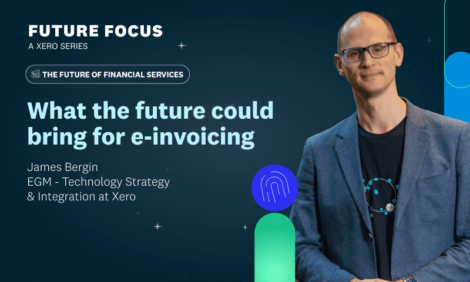
What the future could bring for e-invoicing

When we look at a technology that has massive future potential, while already sitting firmly in the here and now, it’s hard to go past e-invoicing. The ability to send and receive invoices directly between accounting systems (and eliminate the need for manual, error-prone PDFs sent via email) offers some very exciting benefits.
E-invoicing is in various stages of adoption around the world, with some governments either mandating or supporting it as a core part of the invoicing process. However, the potential for what it can do still remains largely unrealised, especially when you think about combining it with other technologies like artificial intelligence, blockchain, smart payments and the ‘Internet of Things’.
Let’s look at one example where this sort of technology could benefit a small business. In this case, a cafe in South Melbourne called JB’s Cafe.
The real meaning of zero-touch
After an unexpected Thursday morning coffee rush, owner JB is down to his last litre of milk by 11am. He opens his supplier’s procurement app and quickly scrolls through every milk wholesaler in Melbourne to compare the price and delivery time. It’s $2 per litre from supplier 1, but the milk won’t arrive until 2pm. Supplier 2 is more expensive at $3, but it will arrive in half an hour — perfect. He taps ‘accept’ and goes back to making coffee for his customers.
Thanks to smart payment technology, the transaction is complete before JB even puts the phone on the counter, with an e-invoice automatically established in all three parties’ ledgers. Payment details are automatically exchanged, and there’s no need for a month-end PDF invoice to be entered anywhere. He doesn’t even need to sign anything before the delivery driver refills the fridge and waves goodbye.
Before this, JB was managing his own bookkeeping. It was all paper and PDF based, so he was constantly falling into the trap of forgetting things, paying suppliers late, and trying to reconcile the numbers after a long day’s grind.
Once he spoke to an advisor who helped digitise his business, they linked up his accounting software to his till, connected it to apps across stock management, rostering and payments, and created an e-invoicing contract for inventory (such as milk). Business suddenly got a lot more beautiful for JB.
The next frontier of e-invoicing
To truly appreciate what potential e-invoicing technology could unlock more broadly, it’s worthwhile really understanding what underpins it: the Peppol network.
Peppol is a secure, global network that simplifies the exchange of electronic documents. It is managed by a non-profit organisation that standardises the way information is structured, so you can send documents (such as e-invoices) directly into other registered software systems, even if your customer or supplier uses a different system. It’s a far cry from current paper and PDF invoicing, which is highly error-prone and cumbersome.
So, what sort of future state could reasonably exist if futuristic technologies were built to work together? Let’s picture another scenario for JB.
When stock got low, sensors in JB’s milk fridge would automatically alert a small business platform that an order for full cream and skim milk were required. The software would then display a list of suppliers with availability, delivery times and prices (and even make a recommendation based on previous history of milk usage).
JB would decide on the best price, and the software would send off the order. Once the milk arrived, a sensor would identify that it had been placed in the fridge, triggering a confirmation to the supplier who could then issue the e-invoice. Over time, the artificial intelligence built into these tools could analyse JB’s sales, and proactively adjust the orders to work around the peaks and dips.
JB might even be prompted to move the usual Friday milk delivery to Thursday, thanks to a promotional fixed wholesale rate. Once he accepts, the delivery cadence is then adjusted to suit.
Of course, this can extend to other suppliers too. Using the same integrated technology, JB’s air-conditioning unit and coffee machine could be linked to an energy management platform supported by solar panels on the roof. This would automatically adjust e-invoices from his electricity supplier based upon his usage (and available sunlight).
As an added efficiency, it may then automatically adjust the air-conditioning during quiet periods to save power. This is commonly known as ‘IoT’ or the Internet of Things, a concept where household items are connected to the internet. Now, JB is no longer captive to fluctuating milk or power prices, with operating expenses down by 10% per month.
Looking to the future
While this may be a hypothetical scenario, the use of e-invoicing is very much a reality. Governments around the world are heavily invested in e-invoicing and driving its adoption — particularly in Australia, New Zealand, Singapore and the UK.
The benefits of increasing efficiency, lowering costs and speeding up payment times is not only something your business or practice can benefit from right now, but it’s a great first step towards preparing for other exciting technologies in the future.
The post What the future could bring for e-invoicing appeared first on Xero Blog.
Source: Xero Blog






